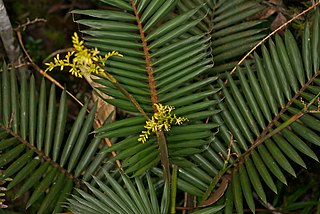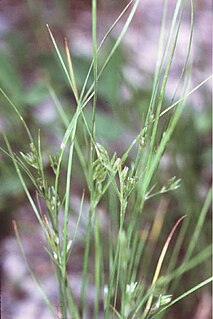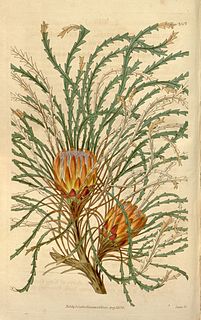
Calamus is a genus of flowering plants in the palm family Arecaceae that are among several genera known as rattan palms. There are an estimated 400 species in this genus, all native to tropical and subtropical Asia, Africa, and Australia. They are mostly leaf-climbing lianas with slender, reedy stems. To aid scrambling some species have evolved hooks on the underside of the midrib, or more commonly by modified "pinnae" or tendrils in the form of stout, backward-pointing spines. These stems may grow to lengths of 200 metres.

Juncus tenuis, the slender rush, is a clump-forming, round-stemmed perennial in the Juncaceae. Slender rush grows to be between 15 and 60 cm tall. Generally considered a weed, it is rarely sold by retailers as a household container plant. Where it is introduced, it is colloquially called path rush, field rush, slender yard rush, poverty rush or wiregrass.

Nepenthes tenuis is a tropical pitcher plant endemic to Sumatra. The species was first collected in 1957, from a remote mountain in the western part of the island. It remained undescribed until 1994, and was only rediscovered in the wild in 2002. Prior to this, N. tenuis was known solely from a single photograph and dried herbarium specimen.

The slender catshark is a small species of catshark belonging to the family Scyliorhinidae. It is found on the upper continental slope off the coast of Suriname, French Guiana and northern Brazil, including the mouth of the Amazon River at depths between 72 to 450 metres. Its it can grow up to a length of 70 centimetres (28 in).

Banksia tenuis is a species of shrub that is endemic to the southwest of Western Australia. It has pinnatifid, serrated or smooth-edges leaves, golden brown and cream-coloured flowers in heads of about fifty-five and glabrous, egg-shaped follicles.
Kopsia lancifolia is a species of plant in the family Apocynaceae. It is a tree endemic to Borneo where it is confined to Sabah.

Kopsia is a genus of plant in family Apocynaceae first described as a genus in 1823. Kopsia is native to China, Southeast Asia, Australia, and various islands of the western Pacific.
- Kopsia angustipetalaKerr - Thailand, Laos
- Kopsia arboreaBlume - S China, SE Asia, N Australia, Andaman & Nicobar Is
- Kopsia dasyrachisRidl. - Sabah
- Kopsia deverreiL.Allorge - Johor
- Kopsia flavidaBlume - Philippines, Maluku, New Guinea, Solomon Is, Vanuatu, Micronesia
- Kopsia fruticosa(Roxb.) A.DC. - Myanmar, Andaman Is
- Kopsia grandifoliaD.J.Middleton - Johor, Anambas Is
- Kopsia griffithiiKing & Gamble - W Malaysia
- Kopsia hainanensisTsiang - Hainan
- Kopsia harmandianaPierre ex Pit. - Vietnam
- Kopsia lapidilectaSleesen - Natuna Is
- Kopsia larutensisKing & Gamble - W Malaysia
- Kopsia macrophyllaHook.f. - W Malaysia
- Kopsia paucifloraHook.f. - Indochina, W Malaysia, Sumatra
- Kopsia profundaKing & Gamble - W Malaysia
- Kopsia rajangensisD.J.Middleton - Sarawak
- Kopsia roseaD.J.Middleton - S Thailand, Kelantan
- Kopsia singapurensisRidl. - Singapore, W Malaysia
- Kopsia sleesianaMarkgraf - Sarawak
- Kopsia sumatranaD.J.Middleton - Sumatra
- Kopsia tenuisLeenh. & Steenis - Sarawak
- Kopsia teoiL.Allorge - W Malaysia
- Kopsia tonkinensisPit. - Vietnam
- Kopsia vidaliiD.J.Middleton - Vietnam
Kopsia larutensis is a species of plant in the family Apocynaceae. It is found in Peninsular Malaysia, Borneo and Thailand.
Kopsia profunda is a species of plant in the family Apocynaceae. It is endemic to Peninsular Malaysia.
Kopsia scortechinii is a species of plant in the family Apocynaceae. It is a tree endemic to Peninsular Malaysia.
Kopsia sleesiana is a species of plant in the family Apocynaceae. It is endemic to the Sarawak region of Malaysia, on the island of Borneo.
Microtropis tenuis is a species of plant in the family Celastraceae. It is a tree endemic to Peninsular Malaysia. It is threatened by habitat loss.

Cystopteris is a genus of ferns in the family Cystopteridaceae. These are known generally as bladderferns or fragile ferns. They are found in temperate areas worldwide. This is a very diverse genus and within a species individuals can look quite different, especially in harsh environments where they experience stress and remain small and stunted. Also, they hybridize easily with each other. Identifying an individual can be challenging. In general these are rhizomatous perennials which may grow in rocky areas or in soil. Their leaves are multiply pinnate, in that each leaflet is divided into smaller parts. The sori are usually rounded and are covered in an inflated bladder-like indusium.
Banksia tenuis var. tenuis is a variety of Banksia tenuis. It was known as Dryandra tenuifolia var. tenuifolia until 2007, when Austin Mast and Kevin Thiele sunk all Dryandra into Banksia. Since the name Banksia tenuifolia had already been used, Mast and Thiele had to choose a new specific epithet for D. tenuifolia and hence for this variety of it. As with other members of Banksia ser. Dryandra, it is endemic to the South West Botanical Province of Western Australia. As an autonym, it is defined as encompassing the type material of the species.
Calamus tenuis is a species of flowering plant in the family Arecaceae. It is native to India, Assam, Bangladesh, Bhutan, Cambodia, Laos, Burma, Thailand, Vietnam, Java and Sumatra.

Kopsia arborea is a tree in the family Apocynaceae.
Kopsia dasyrachis is a tree in the family Apocynaceae.
Kopsia pauciflora is a tree in the family Apocynaceae. The specific epithet pauciflora means "few-flowered".
Kopsia rajangensis is a tree in the family Apocynaceae. The specific epithet rajangensis refers to the Rajang River in Borneo, near which the species was initially surveyed.

Kopsia singapurensis is a species of plant in the family Apocynaceae. It is native to Peninsular Malaysia and Singapore. It is threatened by habitat loss. It can grow up to five metres tall. When the plant is cut, white latex is produced. The flower has five petals. In Singapore, the tree can only be found in the Nee Soon Swamp Forest. In the wild, it flowers only twice a year, but when cultivated, it is free-flowering if grown under the right conditions.









